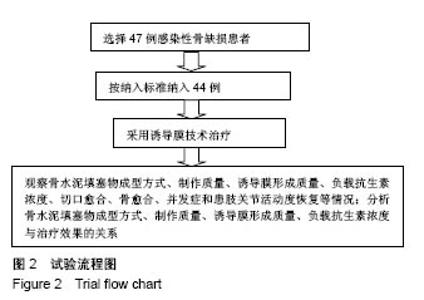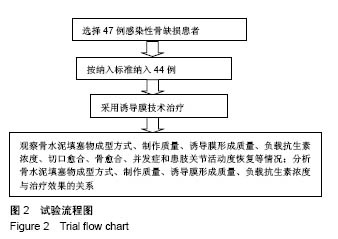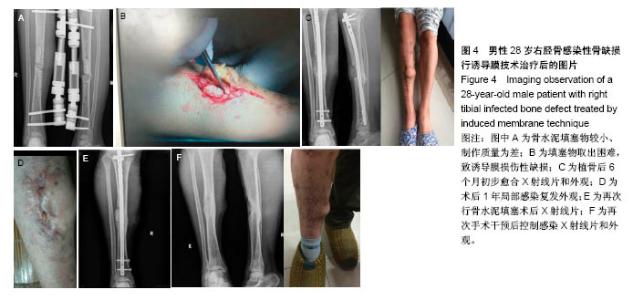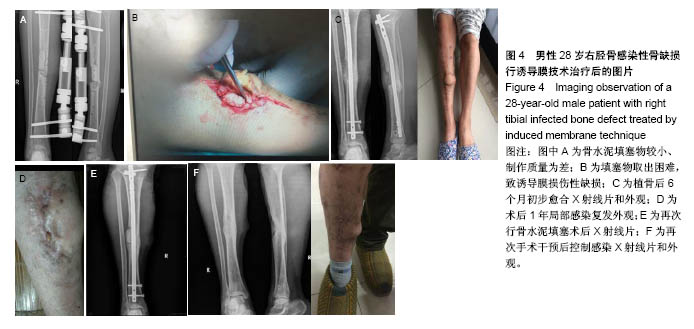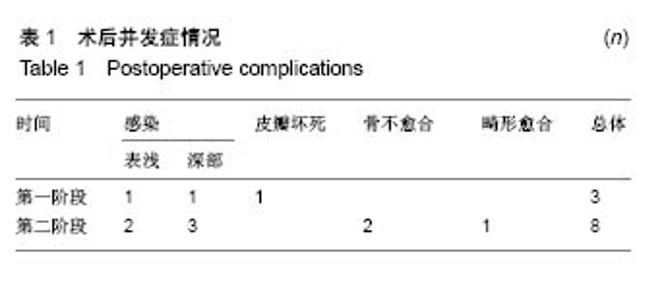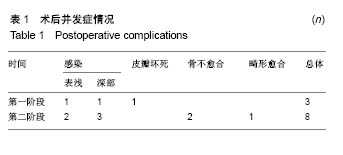| [1] Masquelet AC,Fitoussi F,Begue T,et al.Reconstruction of the long bones by the induced membrane and spongy autograft.Ann Chir Plast Esthet.2000;45(3):346-353.[2] 殷渠东,顾三军,孙振中,等.钛网打压植骨重建四肢长骨节段骨缺损[J].中国组织工程研究,2012,16(48):9096-9100.[3] Karger C,Kishi T,Schneider L,et al.Treatment of posttraumatic bone defects by the induced membrane technique.Orthop Traumatol Sur Res.2012;98(1):97-102.[4] 陈宇杰,周耀东,刘德荣,等.Masquelet技术治疗创伤后骨缺损[J].中华创伤骨科杂志,2013,15(6):540-542.[5] Pannier S,Pejin Z,Dana C,et al.Induced membrane technique for the treatment of congenital pseudarthrosis of the tibia:preliminary results of five cases.J Child Orthop.2013;7(6):477-485.[6] 汪小华,傅景曙,沈杰,等.诱导膜技术治疗胫骨创伤后骨髓炎[J].中华创伤杂志,2015,31(4):299-302.[7] 张辉,殷渠东,顾三军,等.空心多孔抗生素骨水泥体外成形、体内灌洗的诱导膜技术治疗骨髓炎[J].中国修复重建外科杂志, 2015,29(11): 1397-1400.[8] 李林,林达生,郝健明,等.Masquelet技术治疗胫骨大段骨缺损的疗效分析[J].中华创伤骨科杂志,2014,16(1):88-90.[9] 郑欣,朱彦丞,邱旭升,等.诱导膜技术应用于骨缺损治疗的研究进展[J].中华创伤杂志,2016,32(2):189-192.[10] 殷渠东,顾三军,芮永军,等.诱导膜技术治疗骨缺损的疗效分析[J].中华骨科杂志,2016,36(20):1284-1293.[11] Taylor BC,Hancock J,Zitzke R,et al.Treatment of bone loss with the induced membrane technique:techniques and Outcomes.J Orthop Trauma.2015;29(12):554-557. [12] Apard T,Bigorre N,Cronier P,et al.Two-stage reconstruction of post-traumatic segmental tibia bone loss with nailing.Orthop Traumatol Surg Res.2010;96(5):549-553.[13] Wong TM,Lau TW,Li X,et al.Masquelet technique for treatment of posttraumatic bone defects. ScientificWorldJournal.2014; 2014: 710302.[14] Christou C,Oliver RA,Yu Y,et al.The Masquelet technique for membrane induction and the healing of ovine critical sized segmental defects.PLoS One.2014;9(12):e114122.[15] Donegan DJ,Scolaro J,Matuszewski PE,et al.Staged bone grafting following placement of an antibiotic spacer block for the management of segmental long bone defects.Orthopedics. 2011; 34(11):e730-735.[16] 刘家国,喻爱喜,赵猛,等.Masquelet技术治疗开放性pilon骨折骨缺损[J].中华创伤骨科杂志,2013,15(9):742-746.[17] 李宗原,唐诗添,王军,等.Masquelet技术联合组织瓣移植修复骨软组织复合缺损[J].中国修复重建外科杂志, 2016,30(8):966-970.[18] Pelissier P,Martin D,Baudet J,et al.Behaviour of cancellous bone graft placed in induced membranes.Br J Plast Surg. 2002;55(7): 596-598.[19] Pelissier P,Masquelet AC,Bareille R,et al.Induced membranes secrete growth factors including vascular and osteoinductive factors and could stimulate bone regeneration. J Orthop Res.2004; 22(1):73-79.[20] Zwetyenga N,Catros S,Emparanza A,et al.Mandibular reconstruction using induced membranes with autologous cancellous bone graft and HA-betaTCP:animal model study and preliminary results in patients.Int J Oral Maxillofac Surg. 2009;38 (12):1289-1297.[21] 魏富达,汪小华,谢肇.PMMA骨水泥与磷酸钙骨水泥诱导成膜及其对成骨活性的差异[J].第三军医大学学报,2015,37(10):973-977.[22] 雷鸣,王敏,张催.万古霉素骨水泥对骨折内固定术后髓内感染的疗效观察[J].抗感染药学,2014,11(5):538-540.[23] 李宗原,唐诗添,王军,等.Masquelet技术联合组织瓣移植修复骨软组织复合缺损[J].中国修复重建外科杂志, 2016,30(8):966-970.[24] El-Alfy BS,Ali AM.Management of segmental skeletal defects by the induced membrane technique.Indian J Orthop. 2015;49: 643-648.[25] Zappaterra T,Ghislandi X,Adam A,et al.Induced membrane technique for the reconstruction of bone defects in upper limb.A prospective single center study of nine cases.Chir Main.2011; 30(4):255-263.[26] Jiang N,Qin C,Ma Y,et al.Possibility of one-stage surgery to reconstruct bone defects using the modified Masquelet technique with degradable calcium sulfate as a cement spacer:a case report and hypothesis.Biomed Rep. 2016;4:374-378.[27] Olesen UK,Eckardt H,Bosemark P,et al.The Masquelet technique of induced membrane for healing of bone defects.A review of 8 cases.Injury.2015;46(Suppl):S44-S47.[28] Taylor BC,Hancock JDO,Zitzke R,et al.Treatment of bone loss with the induced membrane technique:techniques and outcomes. J Orthopaedic Trauma.2015;29(12):554-557.[29] Sasaki G,Watanabe Y,Miyamoto W,et al.Induced membrane technique using beta-tricalcium phosphate for reconstruction of femoral and tibial segmental bone loss due to infection:technical tips and preliminary clinical results.Int Orthop.2018;42(1):17-24.[30] Hernigou P,Dubory A,Homma Y,et al.Single-stage treatment of infected tibial non-unions and osteomyelitis with bone marrow granulocytes precursors protecting bone graft.Int Orthop.2017;13: e1-8.[31] Aurégana JC, Béguéa T,Rigoulotb G,et al.Success rate and risk factors of failure of the induced membrane technique in children:a systematic review.Injury.2016;47(S6):S62-S67.[32] Gupta G,Ahmad S,Mohd Z,et al.Management of traumatic tibial diaphyseal bone defect by “induced-membrane technique”.Indian J Orthop.2016;50(3):290-296.[33] Morelli I,Drago L,George D,et al.Masquelet technique:Myth or reality? A systematic review and meta-analysis.Injury. 2016; 47(S6):s68-76.[34] Julia M,Jörg W,Reto B,et al.Infected tibia defect fractures treated with the Masquelet technique.Medicine. 2017;96(20):e6948.[35] 殷渠东,孙振中,顾三军,等.短缩-延长术治疗创面难修复胫骨大段骨缺损合并软组织缺损[J].中国修复重建外科杂志, 2013,27(12): 462-1465. |
